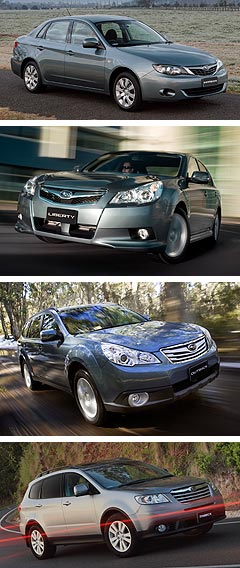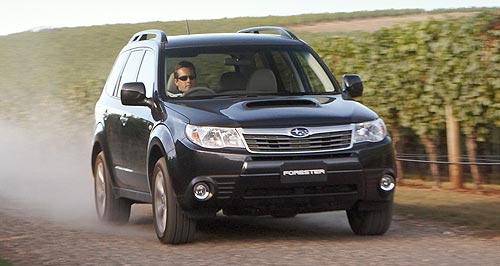Make / Model Search
Future models - Subaru - ForesterSubaru reveals next-generation boxerBoxing harder: Subaru’s next-generation boxer engine delivers slightly more torque. All-new flat-four petrol engine emerges from Subaru – destined for the 2011 Forester24 Sep 2010 SUBARU has revealed a brand-new boxer engine that will make its Australian debut in the model year 2011 version of the Forester – the country’s best-selling compact SUV – early next year. Claimed to be only the third all-new petrol engine of its type since the company adopted the unusual horizontally opposed engine architecture – also employed by Porsche, in six-cylinder guise – in the Subaru 1000 in 1966, the redesigned flat four also represents the engine’s first “overall renewal” since the second-generation boxer four emerged 21 years ago in the first Liberty model of 1989. Of course, since then Subaru’s trademark boxer engine has also been boosted with turbocharged versions for the ground-breaking Impreza WRX and subsequent STI performance flagship, plus the Forester XT and the Liberty GT, as well as being produced in both 2.0 and 2.5-litre displacements.  From top: Subaru Impreza, Subaru Liberty, Subaru Outback, Subaru Tribeca. From top: Subaru Impreza, Subaru Liberty, Subaru Outback, Subaru Tribeca.The flat petrol four has also been joined by 3.0-litre and now 3.6-litre six-cylinder petrol boxer siblings and Subaru’s first diesel boxer engine is now also available in the Forester and Outback. Subaru’s MkIII petrol-four will be produced in both 2.0-litre (for garden-variety Impreza variants) and 2.5-litre capacities for the Japanese domestic market – the latter being the engine size found in all other Subaru models currently sold in Australia, bar the six-cylinder Tribeca SUV. Only details of the new 2.0-litre engine have been revealed, but compared with the Impreza’s existing 1994cc DOHC flat four with AVCS variable valve timing, the completely re-engineered 1995cc version comes with a much shorter cylinder bore (84 versus 92mm) and a much longer stroke of 90mm – versus 75mm for the outgoing engine. Subaru says the more compact combustion chamber wrought by transforming its volume-selling boxer engine from a short-stroke (oversquare) design to one with long-stroke or under-square cylinder dimensions – in which the piston stroke is longer than the cylinder’s bore diameter – brings big advantages in performance output, emissions and fuel consumption. Of course, Subaru says it also builds on the inherent strength of the boxer engine, which was made famous by the Volkswagen ‘Beetle’ designed for Adolf Hitler by Ferdinand Porsche, which include a relatively low weight, size, centre of gravity and vibration. Other new features include a higher 10.5:1 compression ratio (up from 10.2:1) that still falls well short of the superbike-like 14:1 compression with which Mazda has equipped its 2011 Sky G petrol engine, lighter pistons and connecting rods that result in lower reciprocating mass, and a “tumble generator valve”. While Subaru’s latest flat petrol four naturally continues to comprise two sets of double overhead camshafts that operate 16 valves with the help of AVCS for both the intake and exhaust valves, a host of other detail changes include a cooled exhaust gas recirculation system and a more compact oil pump, which is said to reduce friction loss by 30 per cent while also improving fuel efficiency and engine response. Surprisingly, Subaru says the result of all this – at least in the new 2.0-litre engine – is that maximum (Japanese-spec) power output remains at 109kW, while peak torque increases just 5Nm, from 191 to 196Nm, at an unspecified engine speed, although Subaru claims it offers improved torque delivery. Currently, the Australian-spec 2.0-litre boxer donk that powers the Impreza XV crossover and the Impreza R, RX and RS sedan and hatch delivers 110kW at 6400rpm and 196Nm at 3200rpm. It also returns unremarkable average fuel consumption of 8.9 litres per 100km in five-speed manual form (8.8L/100km with a four-speed auto), and emits an average 210 grams of CO2 per kilometre (208g/km auto). No fuel consumption or emissions figures have been released, but Subaru claims some domestic versions of the new engine will be 10 per cent more fuel-efficient. However, it is not clear whether the engine meets Europe’s latest EU5 emissions standard or the even stricter upcoming EU6 standard. Expect whatever fuel consumption and emissions reductions the 2.0-litre engine achieves to also apply to the new 2.5-litre boxer, which should replace the 126kW/229Nm naturally aspirated engine that powers mainstream Foresters, before also superseding the Liberty, Outback and Exiga’s 123kW/229Nm engine. Naturally, a turbocharged version of the bigger new engine should eventually also replace the Forester XT’s 169kW/320Nm engine, the WRX’s 195kW/343Nm engine and the Liberty GT’s 195kW/350Nm engine. Subaru Australia managing director Nick Senior confirmed the new boxer engine – so-called because the sideways piston and cylinder layout resembles the punching action of a boxer – will first be seen here in some variants of the MY11 Forester, due for launch early next year. “This is an exciting engineering development from FHI (Subaru parent company Fuji Heavy Industries),” he said. “They’re renowned for the durability of their engines and this new unit will take the sophistication to a whole new level that we’ll look forward to experiencing in some versions of our best-selling Forester next year.” FHI has built a new factory at its Gunma Oizumi Plant in Japan to build the new engine.  Read more14th of September 2010  Subaru sets fire to ForesterFrom mild to wild for Subaru Forester in global launch at Sydney motor showAll future models Alfa Romeo Alfa Romeo Abarth Abarth Alpine Alpine Alpina Alpina Audi Audi Aston Martin Aston Martin BMW BMW Bentley Bentley Chery Chery Brabham Brabham Chrysler Chrysler Chevrolet Chevrolet Cupra Cupra Citroen Citroen DS DS Dodge Dodge Fiat Fiat Ferrari Ferrari Foton Foton Ford Ford Great Wall Great Wall FPV FPV Haval Haval GWM GWM Honda Honda Holden Holden Hummer Hummer HSV HSV Infiniti Infiniti Hyundai Hyundai Jaguar Jaguar Isuzu Isuzu Kia Kia Jeep Jeep Land Rover Land Rover Lamborghini Lamborghini Lexus Lexus LDV LDV Mahindra Mahindra Lotus Lotus Mazda Mazda Maserati Maserati Mercedes-AMG Mercedes-AMG McLaren McLaren MG MG Mercedes-Benz Mercedes-Benz Mitsubishi Mitsubishi Mini Mini Opel Opel Nissan Nissan Peugeot Peugeot Pagani Pagani Proton Proton Porsche Porsche Renault Renault Ram Ram Rover Rover Rolls-Royce Rolls-Royce Skoda Skoda Saab Saab SsangYong SsangYong Smart Smart Suzuki Suzuki Subaru Subaru Toyota Toyota Tesla Tesla Volvo VolvoForester pricingMotor industry news |
Click to shareSubaru modelsResearch Subaru All future models Alfa Romeo Alfa Romeo Abarth Abarth Alpine Alpine Alpina Alpina Audi Audi Aston Martin Aston Martin BMW BMW Bentley Bentley Chery Chery Brabham Brabham Chrysler Chrysler Chevrolet Chevrolet Cupra Cupra Citroen Citroen DS DS Dodge Dodge Fiat Fiat Ferrari Ferrari Foton Foton Ford Ford Great Wall Great Wall FPV FPV Haval Haval GWM GWM Honda Honda Holden Holden Hummer Hummer HSV HSV Infiniti Infiniti Hyundai Hyundai Jaguar Jaguar Isuzu Isuzu Kia Kia Jeep Jeep Land Rover Land Rover Lamborghini Lamborghini Lexus Lexus LDV LDV Mahindra Mahindra Lotus Lotus Mazda Mazda Maserati Maserati Mercedes-AMG Mercedes-AMG McLaren McLaren MG MG Mercedes-Benz Mercedes-Benz Mitsubishi Mitsubishi Mini Mini Opel Opel Nissan Nissan Peugeot Peugeot Pagani Pagani Proton Proton Porsche Porsche Renault Renault Ram Ram Rover Rover Rolls-Royce Rolls-Royce Skoda Skoda Saab Saab SsangYong SsangYong Smart Smart Suzuki Suzuki Subaru Subaru Toyota Toyota Tesla Tesla Volvo VolvoForester pricingMotor industry news |











Facebook Twitter Instagram